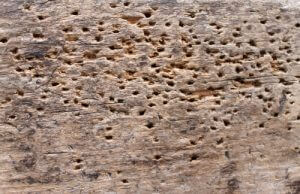Woodworm can be a cause for concern especially if you own a house that has a heavy structure. These small larvae burrow deep into the wood found in timber supports, joists, furniture and floorboards where they hibernate for a long period of time before hatching into adult beetles which will then re-emerge from the wood. At this point, the cycle of laying eggs which turn into larvae repeats once more. With woodworm known to be more active between the months of May and October there will be many homeowners who spot telltale signs of an infestation which is why as one of the South West’s leading woodworm treatment specialists, we feel compelled to shed more light into the way that common wood boring insects function and why.
There Are Many Different Kinds Of Wood Beetle
The mistake many individuals make is to assume that the “wood beetle” is one single species across the board when in fact there are around four common species of wood boring insect. These include the Death Watch, Common Furniture, Wood Boring Weevil and House Longhorn Beetle. The most commonly dealt with species is the Common Furniture Beetle
The Pregnant Femail Lays Her Eggs On Timber
The process begins when a pregnant female timber beetle lands on a piece of timber to lay her eggs. Typically the female beetle will look for cracks, crevices and any openings on the surface of the wood to lay the eggs as embedding them slightly below the surface gives them the best chance of protection from predators. The female will lay anywhere between 30-70 eggs at a time.
Hatching & Tunnelling Into Wood
Within 5-6 weeks of the eggs being laid, they will start to hatch and the larvae will start to bore their way down into the wood, creating a network of bore tunnels throughout the timber consuming it as they grow. This process of burrowing continues for 4-5 years so you can imagine how much structural damage can be done by 50 larvae eating through a piece of timber over 4 years. When selecting the wooden surfaces to lay eggs on, female wood beetles often look for moist timber that has a soft consistency as this is easy to bore through for their larvae.
Maturing Into A Beetle & Exiting The Wood
After four years or so, the larvae will start to mature around springtime. It will start to bore closer to the surface and create a pupil chamber, a hollowed out cavity which is used as a resting spot where it will spend about five weeks maturing into an adult beetle. After this maturation period is complete and the young beetle has gathered strength and hardened its shell, it then chews its way to the surface. This is why pieces of infested timber show a smattering of multiple 2mm round holes on their surfaces.
Mating Phase & Repeat
With a new generation of adult female and male beetles fresh into the world, mating becomes the next stage in the process. Male beetles do not live long and have an average lifespan of between 3-4 days so within this time will try mate with as many females as possible. The females tend to live around three times longer than the males in which time they need to get pregnant, find a suitable area to lay eggs before inevitably expiring.
Woodworm Treatment
Every time the cycle repeats, newly pregnant beetles will move on and look for the nearest suitable piece of timber in which to lay eggs. In this sense, it is easy for woodworm infestation to systematically move through a property in cycles, weakening the wood every time. If you have concerns about woodworm, it is essential that you arrange a professional woodworm timber survey as soon as possible.



